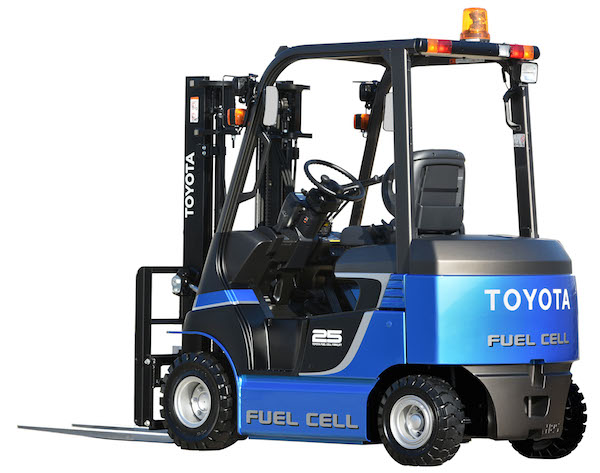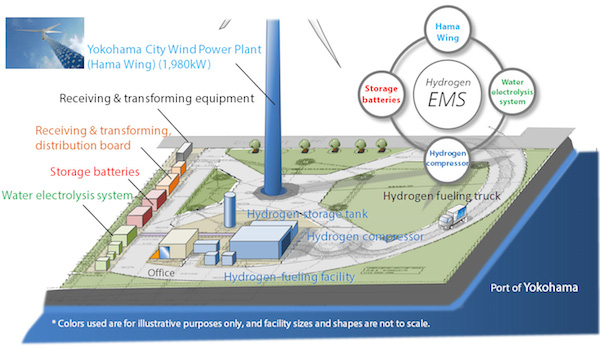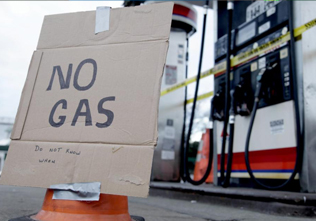The Intertubes have been buzzing with news that Toyota is spearheading a public-private partnership that will deploy wind energy to generate hydrogen for whole fleets of zero emission electric vehicles. That’s the good news. The bad news is that the EV fleets in question are not exactly Tesla-level exciting. They’re forklifts, to be precise. Oh well, baby steps!
Challenges For Hydrogen Fuel Cell EVs
Back in the heat of the 2012 US presidential race, candidate Mitt Romney gave renewable energy and EV technology the horselaugh, claiming that “you can’t drive a car with a windmill on it.”
That’s a somewhat disingenuous take on personal mobility fuel sourcing, since you can’t drive a car with an oil refinery on it either, but whatever. Fast forward a mere four years later and battery EV sales are soaring in the US, and the wind and solar share of US electricity generating capacity has been climbing rapidly.
Fuel cell EV technology has also been on the rise, but more slowly, and so far it is not competitive in the consumer mobility market on cost and refueling convenience. Fuel cell EVs also have to deal with the same legacy fuel sourcing issues that used to dog battery EVs, namely, the use of fossil fuels to generate electricity. In the case of hydrogen fuel cells, the primary source of hydrogen is natural gas, though renewable hydrogen is beginning to emerge.
Despite all the challenges, a number of governments around the globe are pushing hard for fuel cell EV technology, including the US state of California.
Toyota is one among a number of global auto manufacturers to dip a toe in the US fuel cell EV market, and the critics have been plenty (that includes our sister site Gas2.org, btw).
Toyota Gets The Last Laugh…Eventually
In terms of rapid adoption and commercialization, one bright spot for fuel cell EVs is the market for electric forklifts. With a super-quick refueling capability and no extra battery storage room needed, fuel cell electric forklifts beat battery forklifts hands-down in terms of the strict space/time continuum demanded by the modern logistics industry.
As competition for the logistics market heats up, there is a direct bottom line motivator for auto manufacturers and forklift purchasers to pump more R&D into improving fuel cell EV technology and lowering the cost, with a ripple effect on the personal mobility market.
The critics may be all over fuel cell EVs now, but Toyota could still get the last laugh.
Toyota And The Wind Powered Hydrogen Fuel Cell EV
That finally brings us around to the new Toyota hydrogen fuel cell EV announcement. Following on the heels of a months-long planning process that launched last fall, the public-private project is designed to demonstrate and analyze the performance of fuel cell electric forklifts under different conditions among two cities in the Tokyo Bay area, Yokohama and Kawasaki.
The demo project will also take a look at supply chain reliability and enable future planning for mass production and the removal of regulatory impediments.
The hydrogen fuel for the forklifts will be generated from water by electrolysis, and electricity for the process will be provided by the Yokohama City Wind Power Plant, aka Hama Wing.
The renewable hydrogen will be compressed and stored at a central location, with the plan being to ensure that there will always be a two-day supply of hydrogen on hand for twelve forklifts divided among four different fleets at a local factory, a produce market, and two warehouses.
Taking processing and transportation into consideration, the partners anticipate that there will be at least an 80 percent reduction in carbon dioxide emissions, compared to using gas-powered forklifts or battery forklifts using grid electricity.
That’s just for starters. The partners anticipate that further reductions will be made as the project progresses.
Don’t hold your breath — the project is still in the preparation phase and it won’t start rolling until next fall in a step-by-step process beginning with just one forklift. The idea is to get the hydrogen delivery system down pat before staging the additional forklifts. Full operation is not expected until some time in 2017.
Why Hydrogen?
The advantages of hydrogen fuel cells are clear in the logistics market, but for general mobility the big question still is, why go through all the trouble of using renewable electricity to make renewable hydrogen, when you could just use all that juice directly in a battery EV?
As described by writer David Z. Morris in Forbes magazine last fall, Japan is making a huge bet on the “hydrogen economy,” but it’s not alone. The European Union is another hydrogen hotspot with a particular focus on renewable hydrogen, an effort that is aimed partly at boosting the domestic auto manufacturing sector.
The US Energy Department is another hydrogen fuel cell EV believer, as demonstrated by the agency’s $35 million round of R&D funding last fall, following on another $35 million round earlier last year.









